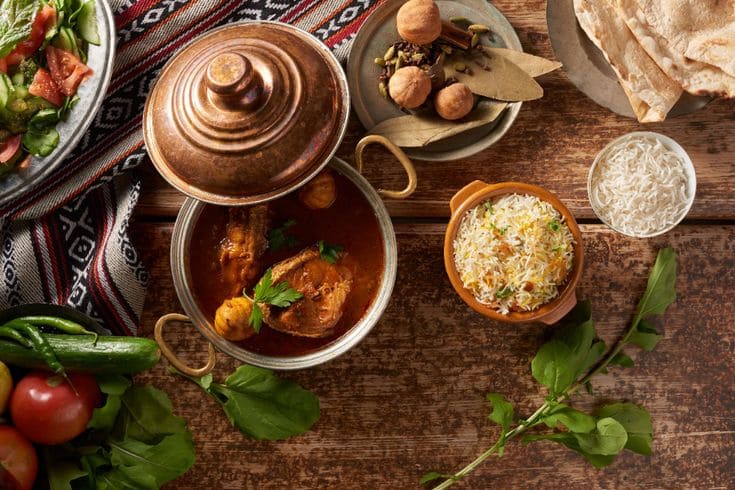Emirati cuisine tradition is more than just food—it is a window into the history, culture, and identity of the United Arab Emirates. Each dish carries stories of the desert, the sea, and the Bedouin lifestyle, reflecting centuries of heritage and innovation. From the spices used to the cooking techniques, Emirati food preserves the culture of a nation while offering a sensory journey that connects past and present.
In this article, we explore how Emirati cuisine tells stories of tradition, highlighting signature dishes, cultural significance, and the modern revival of culinary heritage.
Roots of Emirati Cuisine Tradition
The foundation of Emirati cuisine tradition lies in the UAE’s geography and lifestyle. Historically, the country’s inhabitants adapted to the desert environment and the coastline, shaping their diets and cooking practices.

- Bedouin Influence: Nomadic life emphasized simple yet nourishing meals, such as dried fish, dates, and rice.
- Coastal Resources: Seafood like hammour and shrimp became staples, often paired with aromatic spices.
- Trade and Spices: The UAE’s role in historical trade brought saffron, cinnamon, and other exotic ingredients, enriching local cuisine.
This blend of influences created a cuisine that is both practical and flavorful, telling stories of survival, trade, and community.
Signature Dishes and Their Stories
Emirati cuisine tradition is best understood through its signature dishes, each of which carries a unique cultural narrative.

- Al Harees: A slow-cooked wheat and meat dish enjoyed during Ramadan and Eid, symbolizing family unity and hospitality.
- Machboos: A fragrant rice dish with meat or fish, showcasing the Bedouin love for spices and communal meals.
- Luqaimat: Sweet dumplings drizzled with date syrup, reflecting the significance of dates in Emirati culture.
- Balaleet: Sweet vermicelli with saffron and cardamom, often served for breakfast during special occasions.
These dishes not only nourish the body but also serve as living reminders of Emirati history and traditions.
Spices and Ingredients: The Language of Flavor
Spices and local ingredients are central to Emirati cuisine tradition. They tell stories about the environment, trade, and cultural exchange.
- Saffron: Imported from Asia, saffron adds both aroma and prestige to celebratory dishes.
- Cardamom and Cinnamon: Common in desserts and coffee, these spices reflect centuries-old trade connections.
- Dates: A staple food that has sustained desert communities, dates appear in both sweet and savory dishes.
- Seafood: Freshly caught fish tells stories of coastal life and the UAE’s reliance on the sea.
The careful combination of these ingredients transforms meals into experiences that convey history and identity.
Culinary Rituals and Social Significance
Emirati cuisine tradition extends beyond the plate; it is deeply intertwined with social rituals and family life.
- Majlis Gatherings: Meals shared in the majlis reinforce hospitality and community bonds.
- Festive Celebrations: Traditional dishes mark special occasions, such as weddings, Eid, and National Day.
- Hospitality Practices: Offering food to guests is a sign of respect and generosity, a cornerstone of Emirati culture.
Through these practices, cuisine becomes a storytelling medium, connecting people across generations.
The Role of Women in Preserving Cuisine
Women have played a vital role in maintaining Emirati cuisine tradition. Their knowledge of recipes, techniques, and ingredients has been passed down through generations.
- Home Cooking: Mothers and grandmothers teach children the secrets of traditional dishes.
- Festive Preparations: Women take the lead in preparing meals for holidays and family gatherings.
- Culinary Innovation: Contemporary Emirati women chefs blend traditional recipes with modern techniques, keeping heritage alive.
By preserving and evolving the cuisine, women ensure that Emirati food remains a living cultural treasure.

Modern Revival and Culinary Tourism
Emirati cuisine tradition is experiencing a renaissance, attracting both locals and international visitors.
- Restaurants and Cafés: Contemporary establishments serve traditional dishes with modern twists, making heritage accessible to a global audience.
- Food Festivals: Events like the Abu Dhabi Food Festival celebrate Emirati flavors and culinary storytelling.
- Cooking Classes and Workshops: Tourists and locals alike learn the secrets behind signature dishes, deepening their appreciation of Emirati culture.
This revival bridges the past and present, demonstrating how traditional cuisine can thrive in a modern, cosmopolitan society.
Fusion and Global Influence
While Emirati cuisine tradition is deeply rooted in local history, it also embraces global influences.
- Innovative Dishes: Chefs combine Emirati spices with international techniques to create unique culinary experiences.
- Cross-Cultural Inspiration: International visitors and residents contribute to the evolving food scene, blending flavors and ideas.
- Promoting Heritage Globally: Through culinary diplomacy, Emirati cuisine reaches global audiences, telling the story of the nation’s rich culture.
The fusion of tradition and innovation keeps Emirati cuisine dynamic while honoring its roots.
Conclusion
Emirati cuisine tradition is a living narrative that tells the story of the UAE’s history, culture, and people. From the simplicity of Bedouin meals to the intricate flavors of festive dishes, every ingredient, spice, and cooking method reflects a connection to the past. Through hospitality, culinary rituals, and modern innovations, Emirati food continues to preserve cultural heritage and inspire generations.
For locals and travelers alike, exploring Emirati cuisine is more than a culinary journey—it is a journey through time, culture, and community. The flavors, aromas, and stories behind each dish remind us that food is a powerful storyteller, keeping the rich traditions of the UAE alive and celebrated across the world.
Do follow UAE Stories on Instagram
Read Next – Dubai Metro milestones: 16 years of iconic transport













